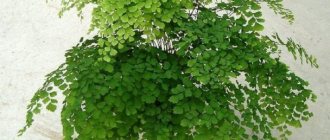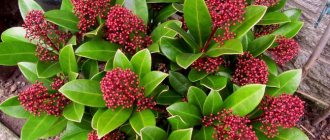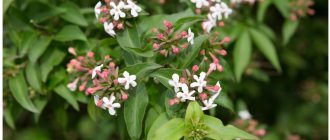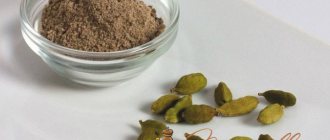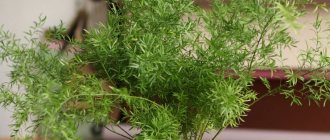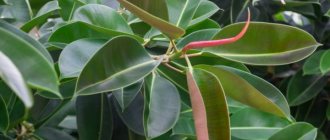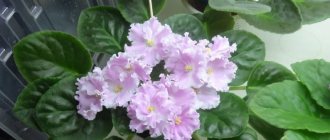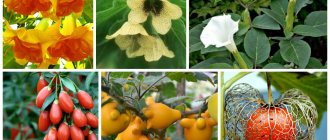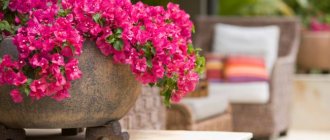00 : 00
00 : 00
Listen to the article “Callisia care at home”
— — 12 : 16
Javascript Css Php Jquery Ajax
Callisia is one of the most beautiful, popular and sought-after indoor plants in modern society. This is a perennial herbaceous plant from the Commelinaceae family. This plant is found in South and Central America and the Antilles, which are characterized by subtropical humidity. There are 12 species of plants in the genus Callisia, and some of them are taken as domestic plants.
Interesting fact. The name Callisia is translated from Greek as “Beautiful Lily”, but despite this, it has little in common with Lily itself, but Callisia has a very close “family” relationship with Tradescantia.
Brief description of cultivation
- Bloom . At home, callisia flowering is a rather rare occurrence. As a rule, this happens in the last summer or first autumn weeks.
- Illumination . Grows well in light shade or in diffused bright light.
- Temperature regime . In the spring-summer period - from 20 to 24 degrees, and in the cold season - from 16 to 18 degrees. Make sure that the room is not colder than 14 degrees.
- Watering . During the growing season, the bush is watered immediately after the top layer of the substrate has dried. In winter, the soil mixture is moistened only after it has dried to a depth of 1/3.
- Humidity . Requires high air humidity. On hot days, you need to systematically moisten the foliage with a spray bottle.
- Fertilizer . The flower is fed in April–October once every 15 days, using a solution of a mineral complex. In other months, the plant is not fed.
- Rest period . November–March.
- Transplant . While the bush is young, it is replanted regularly once a year, and older specimens are subjected to this procedure less often (once every 2 or 3 years).
- Reproduction . Layering, apical cuttings and dividing the rhizome.
- Diseases . The decorative quality of the plant may suffer due to improper care or unsuitable growing conditions.
- Pests . Spider mites and thrips.
- Properties . The flower reacts extremely negatively to tobacco smoke.
Where is Callisia from?
Homeland of Kallisia
South America is considered, and more precisely, its subtropical and tropical regions. She loves humid places with partial shade. Callisia is also widespread in Mexico and the Antilles.
In the natural range there are about twenty species of Callisia. But in indoor and greenhouse floriculture, several species of this amazing plant are known. We'll talk about them a little below.
Possible problems
Callisia diseases
Indoor callisia is extremely resistant to various diseases. But if you constantly violate the rules of care or the flower is not provided with optimal conditions for existence, then problems may arise with it:
- Drying of the tips of leaf blades . You water the bush too sparingly or rarely, and the air in the room is very dry.
- The shoots stretch out and the foliage flies away . Excessively poor lighting.
- The leaves are flying off en masse, and rot has appeared on the root system . Liquid regularly stagnates in the substrate. This may be due to frequent wetting of the substrate or poor drainage.
Pests
Spider mites and thrips can settle on the plant. These pests are sucking, that is, they suck out the juice from the leaf blades, which is why they turn yellow and die. The bush itself begins to wither. Acaricides are used to get rid of ticks, and insecticides are used to get rid of thrips. The bush should be sprayed in a well-ventilated area or outdoors, as these drugs are dangerous for people.
What does it look like
The plant is decorative, the length of the stem does not exceed 15 cm. The shoot spreads, so it is placed in hanging flowerpots. A more famous type of plant is fragrant callisia, or golden mustache. The creeping variety is a different species.
Callisia creeping
If the first plant has oblong leaves up to 20-30 cm long, the second is distinguished by small heart-shaped elements in two rows on the stem. The front surface is green, the back is lilac-violet. The visible part of the leaf is dotted with small purple dots.
For your information! It blooms extremely rarely indoors, when small white elements appear in the leaf axil on a thin branch.
Callisia grows quickly and in natural conditions covers the ground with a carpet. Prefers rocks and stones, forming garlands on them. Creeping callisia is a species that is not similar in appearance to the golden mustache.
Description and characteristics of the plant
Callisia is distinguished by creeping stems. Sometimes you can find plants with erect stems. Their homeland is the subtropical and tropical part of America. Here they grow in damp areas.
Gardeners for home use recommend two types of this plant – elegant callisia or creeping callisia. But many people prefer to grow a medicinal variety - golden mustache.The most suitable place for growth is a warm, fairly bright room with a constant flow of fresh air.
It is not recommended to leave the collision in rooms saturated with various odors. In spring and autumn, pots can be taken out onto the veranda or balcony. It is better to plant it in wide vases; it is permissible to create compositions with other plants.
If you have animals in the house, then you need to purchase this plant with caution. After all, many species, for example, fragrant callisia, as well as creeping callisia, can cause allergies in them, manifested in discoloration of the skin and itching.
Kinds
The Callisia genus includes 12 species of plants, but the following 5 are suitable for indoor keeping.
Callisia elegans (elegant or graceful callisia).
The height of this variety can reach 40 cm. The shoots have a creeping appearance. The color of the leaves is dark green, their upper part is decorated with white stripes, the lower part is purple. The shape of the leaves is oval, the tips are pointed. The stems and leaves have a fleecy structure. During flowering, white buds grow at the tips of the shoots.
Callisia tehuanttepecana (Tehuantepec).
Resembles an elegant variety, but its leaf blade lacks light stripes. Blooms with bright pink flowers.
Callisia navicularis (scaphoid)
The stems of this species are short, the leaves are green in color, and brownish-purple on the inside. The leaves are boat-shaped, their length is 2 cm, width is 1.5 cm. If the crop is kept under bright sunlight, the leaves become covered with a scarlet tint.
Callisia repens (creeping)
This variety grows up to 10 cm and is characterized by fairly rapid growth. The stems of the crop are thin. This is a small-leaved plant, the length of the leaves is no more than 2 cm. The outer side of the leaf blade is covered with pale purple specks, and a burgundy tint is noticeable on the inside. This is one of the most popular indoor types. The Pink Lady variety is especially in demand among flower growers.
Callisia fragrans (scented or "golden mustache")
The height of the plant can reach 1.5 m. The specimen has erect and horizontal shoots. On erect stems, the leaves grow up to 30 cm in length, their width is 5-6 cm. Horizontal sprouts are tendrils with leaf panicles. This species blooms at the end of winter, however, at home, flowering is a rather rare occurrence. The buds are small, modest, and primitive.
Types of domestic callisia with photos and names
Callisia eleganta (graceful)
Herbaceous perennial with creeping stems. The height of the plant is 30-40 cm, the oval leaves pointed at the ends are located on both sides of the stem. The surface of the leaves is velvety, there are silvery-white stripes, which are purple on the reverse side. White flowers appear in late summer.
Callisia fragrant
The well-known second name is Golden Mustache. The plant has healing properties, its height reaches 70-120 cm. The leaves are thick and fleshy on both sides, they are represented by two types: erect and oblong up to 30 cm long, as well as horizontal liana-like shoots. Flowering occurs at the end of winter, the buds are noticeable, but the aroma is bright.
Callisia creeping
A perennial with small leaves, reaching a height of up to 10 cm. The stems are characterized by thick leaves arranged in two rows. The peculiarity of creeping callisia is that it grows very quickly. The bush spreads over the surface, forming a green carpet.
Callisia navicularis
This plant is a type of succulent, its stems are short, its leaves are thick, with a lot of juice. The leaves are up to 2 cm long; when exposed to the sun for a long time, they acquire a red tint.
Caring for callisia at home
Lighting and location selection
Indoor collision needs a lot of bright light, which should be diffused. Be sure to shade the bush from direct sunlight. If the room is sunny, then the bush can be placed away from the window. It is extremely undesirable to place this plant in the kitchen, because it reacts negatively to various fumes, tobacco smoke, impurities in the air, etc. In order for callisia to feel good, it needs to be provided with regular ventilation of the room, and it can be moved during the warm season to the street or to the balcony.
You can decorate not only your apartment or dacha with callisia; it also feels quite normal in the office. However, special attention must be paid to ventilation. Avoid drafts, as they are even more dangerous for the plant than stuffiness.
Temperature
Callisia feels normal in the summer at temperatures from 20 to 24 degrees, and in winter - from 16 to 20 degrees. But remember that the flower must be protected from cold and sudden temperature changes. Make sure that in winter the room is not colder than 14 degrees.
Watering
In spring and summer, soft water is used to water the collision, the temperature of which should be close to room temperature. The substrate in the pot is moistened immediately after its top layer dries. In autumn and winter, the collision is watered less frequently and sparingly, especially if it is in a cool room. But remember that the soil mixture in the pot should not dry out completely, as this can lead to the death of the bush. Also, make sure that when watering, the liquid does not get into the middle of the leaf rosette, otherwise the plant may rot.
Spraying
Because of its love for high levels of humidity, Callisia repens requires irrigation. If you apply it with a coarse spray, then streaks will remain on the plate. Therefore, it is better to purchase a fine spray nozzle.
Note! From time to time you can arrange a shower for the foliage by placing it under heated running water.
Humidity
The recommended humidity level for the plant coincides with the optimal parameter in a house for people to be in - 60-70%. To achieve this level in temperate latitudes, you need to use a humidifier. To maintain optimal conditions, it is removed from the battery in winter.
Callisia pot
After purchasing a plant from a flower shop, it is not replanted. When the young planting grows slightly, you can replant it. To do this, choose the right container: the pot should be wide, but have a small depth.
It is better to choose a container made of ceramic, but often people buy plastic pots - they are also suitable.
One of the important conditions is the presence of a durable, spacious pallet.
Priming
There are ready-made soil mixtures for tradescantia and callisia on sale, since they belong to the same family. You can prepare the composition yourself. The requirements for the substrate are simple: it must be nutritious, not retain excess moisture, but also not be overly porous. These parameters correspond to a mixture of peat, humus, sand, turf and leaf soil.
Callisia transplant
Feeding
Callisia needs feeding during the active period. A complex fertilizer for tropical flowers is used. Fertilization regime: weekly, from April to October.
Trimming
Like any plant, callisia needs timely pruning when cared for at home. It is better to do this in the spring, when there is abundant growth of shoots. Pruning helps give the bush its traditional shape.
To make the plant more lush, several cuttings are planted in a pot at once. The planting tolerates pruning painlessly.
Care
Location and lighting
Its variegated color requires diffuse lighting and does not tolerate direct sunlight. The plant can be safely placed in the back of a bright room; callisia is suitable for offices and very large rooms. Window sill - western or eastern window, be sure to shade it in bright sun. To ensure that the plant grows evenly, turn the pot to the light with a new side every week.
If people smoke in the room and do not ventilate it, callisia will not survive there for long. Open the windows more often, and in the summer take the plant to an open balcony or outside.
Temperature
Callisia is thermophilic, so the suitable temperature for winter is not lower than +14 degrees, in summer - +20-25 degrees. It cannot withstand sudden drops in temperature. Do not place the flower near heating devices; cover the radiators with blankets.
Watering
Water - as the top layer of soil dries out (both in spring and summer), regularly, preferably in the evening.
In winter, you need to water less often, but again, proceed depending on the ambient temperature. The water for watering callisia is soft, purified from harmful impurities and chlorine. Of course, not straight from the tap. Train yourself to first let the liquid sit for several hours in a container without a lid.
Humidity
Air with a high level of humidity is suitable for callisia, so regularly spray the leaves with a spray bottle and brush off the dust from the plant with a soft brush (or wipe with a damp soft sponge).
Transfer
Young specimens should be replanted every spring, mature ones – once every two years. The composition of the soil should always be the same.
Prepare the planting soil yourself: mix one part each of leaf and turf soil, peat, humus and sand. Don't forget to disinfect the mixture by calcining it in the oven or keeping it in the freezer for a day. Be sure to place a 1.5-2 cm layer of drainage on the bottom of the pot (expanded clay or small pebbles, broken shards).
Transfer
Some experts recommend planting a new flower instead of replanting. This is explained by the fact that the stems of the plant become bare with age and its decorative value decreases. If a flower lives in the house for a long time and you are used to it, then it is better to replant it. This is done annually with young plants, and with adults – after two to three years. The florist decides what to do.
The plant needs to be replanted into another container with good drainage and new soil. This can be done throughout the year, but better in the spring. You can prepare the soil yourself. To do this, turf and leaf soil from the garden, humus, peat and sand are taken in equal proportions.
Description
Callisia of the genus Callisium, class Monocots, family Commelinaceae, perennial and evergreen. According to official data, the genus includes 20 species. The nature of the stems is creeping and erect. The genus collision contains plants that can cause allergies. The varieties “Fragrant” and “Creeping” are equated to them. Among flower growers, the species “Elegant” and “Golden Us” are in demand. By the way, “Golden Us”, another name for this variety – callisia “Fragrant”, has medicinal and healing properties known to many people.
Benefits and harms
Creeping callisia, like its other varieties, has a positive effect on the body. Its juice is rich in minerals and vitamins. Beta-sitosterol in callisia helps with atherosclerosis, thyroid diseases, metabolic disorders and other diseases. From the practice of traditional healers, it is known that the medicinal properties of callisia are similar to ginseng and Rhodiola, although this has not been proven by science. When a disease occurs, each person decides for himself whether to be treated in the traditional way or in the folk way. But what has been definitely proven is the cleansing effect of the plant.
By planting a flower, apartment owners receive a free and very beautiful air purifier. The energy of creeping callisia has a positive effect on the home atmosphere. With this plant, peace and mutual understanding reign in the house. The antiseptic properties of flower phytoncides have a beneficial effect on humans. Therefore, it is recommended to place it in the bedroom for children. The blooming of callisia is the first sign that the energy in the room is positive and there are no problems in the house.
Fragrant callisia or golden mustache (Callisia fragrans)
A great tropical plant for beginners. Typically these plants are green or variegated green and cream in color. When exposed to large amounts of light, they can develop purple hues on their leaves. In fact, there are plants that are more purple than green.
The name "false bromeliad" is sometimes used to refer to this plant. In bright light conditions, the leaves lay down and give them the appearance of a bromeliad. But in partial sun it resembles a dracaena with a more vertical leaf pattern.
Mistakes and care problems
Errors in caring for callisia are associated with violation of the rules for its maintenance. Knowing about the tropical origin of the flower, the owners place it on the window in the hottest place, in winter - closer to the radiator.
If there is a cat in the house, then you need to protect the flower from its teeth, since animals love to eat indoor flowers. If placed in a draft, it will die. If you allow a temperature drop in winter, the leaves will lose moisture and become flabby. The sprouts will die.
Callisia is a plant from the Tradescantia genus that grows naturally in tropical latitudes. About 12 types of flowers are grown as indoor plants. Callisia propagates by cuttings and layering. Requires frequent watering and irrigation in the summer.
Transplantation and care
Callisia grows quickly, so mature plantings can be replanted in the fall or spring every year. The diameter of the new container should be 3 cm larger than the old one. The day before transplanting, water the plant thoroughly so that the roots can be removed without any problems. The transplant process itself goes like this:
- Pebbles are placed at the bottom of the pot and sprinkled with a layer of a mixture of turf soil, sand and humus;
- the plant is taken out and, together with a lump of earth, placed in a prepared container;
- voids are filled with soil mixture;
- water the planting.
Attention!
If there is mold in the old soil, the roots of the plant are washed in a weak solution of potassium permanganate.
Callisia loves light, but does not tolerate direct sunlight. In summer she will feel comfortable on a western or eastern window, and in winter - on a southern one. The plant tolerates light shade well, so it can be placed deep into a bright room. Callisia can exist in complete shade. However, in this case, its stems stretch out and the gap between the leaves increases, which is not very beautiful. The plant loves ventilated rooms. It should not be placed in the kitchen or in rooms where people smoke. In the summer it can be taken outside.
In summer, it is recommended to keep callisia at a temperature of +20-25 °C. In winter, this figure can be reduced to +16 °C. In any case, the air temperature should not fall below +14 °C. Temperature fluctuations and drafts are unacceptable. If callisia is exposed to high temperatures in winter, it will stretch out excessively. Coolness promotes the appearance of new leaf plates.
Diseases and pests
Callisia when grown at home is subject to the following problems:
- Callisia stems stretch out - the plant does not have enough light.
- Callisia grows slowly - there is a lack of fertilizing.
- Small and pale young leaves - lack of mineral fertilizers.
- Callisia leaves are soft - the ambient temperature is too low.
- The bases of the leaves rot - liquid gets into the center of the rosette when watering.
- Brown spots on callisia leaves mean the air in the room is too dry.
- The plant grows quickly - it is considered a natural process; to prevent it, rejuvenation by cuttings is used.
Among other common problems, plant growers note root and stem rot. Diseases appear due to the moisture of the earthen clod and improperly organized drainage. Pests that attack callisia: spider mites, thrips and scale insects.
Callisia navicularis
It is native to Mexico and is often listed under the synonym Tradescantia navicularis. This succulent can vary greatly depending on its growing conditions. When grown in full sun, the sun leaves are next to each other and they may appear purple in color.
A creeping evergreen perennial plant, rooting at the nodes with some short stems growing upright with tightly intersecting leaves. Other stems have leaves that are more open and spread out over the ground, producing short stems and flowers. The stems are succulent and tightly pressed with hard lanceolate leaves, they are waxy, held in an arrangement on opposite sides of the stem. These unique leaves are bronze-green on top and streaked with purple underneath and are said to resemble the plates of medieval armor. In summer, when they grow in bright light, the bright lilac-pink flowers, partially hidden in leaf-like bracts, open in the morning and close in the late afternoon, for just one day with successive flowers not appearing for several more days.
This is an attractive container plant with interesting foliage. Excellent as a planting companion in hanging baskets.
Medicinal properties of fragrant callisia
For a long time after the plant was introduced into cultivation in Europe as an indoor flower, it served a purely decorative function. But at the beginning of the twentieth century, chemical and botanical studies were carried out, during which the presence of a number of healing components in the composition of its plant juice was confirmed. Repeated studies took place in the 80s on the basis of the Faculty of Pharmacy of the Irkutsk Medical University, where a group of young scientists set the goal of finding out whether drugs made on the basis of callisia are so effective. During experimental development, the presence of two valuable flavonoids in parts of the plant was confirmed - quercetin and kaempferol, cholesterol-lowering sitosterol and many useful elements such as copper, chromium, iron and others.
Of course, one should not consider callisia and the remedies derived from it as a panacea for all diseases, but their proper use can really have a beneficial effect on the body and become an effective aid in the treatment of many ailments.
Like all home-made herbal preparations, callisia derivatives should be used with great caution and with competent medical support.
Description of the plant
Callisia (Callisia) is a small but very colorful genus of plants, the belonging of whose representatives to the Commelinaceae family is easy to guess not only by their rare flowering. Callisias at first seem original, although over time they reveal more and more qualities similar to Tradescantia. But it’s not so easy to guess that these are also unusual succulents.
Callisias are ground cover, leafy succulents that constantly grow in width, but also quickly age, losing their lower leaves. They create pillows, spreading in breadth; they may not exceed 10 cm in height, and may even seem massive.
The root system of callisias is weak and superficial. All callisias are characterized by creeping, flexible and fragile, densely leafy shoots. Callisias constantly grow, produce shoots, and in indoor format, although they do not create the same turf as in nature, they still turn into lush pillows.
The leaves of callisias are stalk-embracing, create the symmetry of two rows, form a rosette at the top of the shoots, and are often flaunted with a purple or brown reverse side. In many species, the leaves are shaped like a boat or boat. The colors of callisias are very variable, but all species are characterized by the appearance of reddish shades and intensification of colors in bright light. At home, callisias almost never bloom.
Callisias, which are grown as ornamental plants, are dangerous for cats and dogs, causing severe allergic reactions. Pet owners should weigh all the risks before purchasing callisia for the interior.
Creeping callisia (Callisia repens). © The Ofy
How does it reproduce
There are several ways to propagate a plant; they differ in the degree of simplicity and speed of obtaining the final result.
Important! The plant can be propagated all year round, but shoots take root better in spring and autumn.
Support
The plant grows quickly, so it needs to be provided with support. To do this, you can install a peg and tie the stem. If it is not there, you can tie a string to the fastening of the flowerpot and shoot along it.
To give the plant the desired shape, you can place a frame made of thick wire crosswise in the pot. A shoot will begin to take off along it and wrap around it as planned.
Apical shoots
The simplest method is cuttings. To obtain a vegetative shoot, you need to separate a part of the stem, consisting of two internodes, from the top. Next, this part is rooted in the soil or placed in water so that the shoot takes root.
By layering
The essence of the method is that part of the stem can be buried in the ground, and after a while it will take root. To implement it, you need a large pot. The second option is to place another container nearby and place the sprout there. When the shoot takes root, it is cut off from the mother bush.
Callisia rosato
A surprisingly easy houseplant. Plant it in a pot, hanging basket or terrarium and place it in a bright place. The stems can range from green to pinkish to cream with a burgundy underside. Callisia rosato sometimes produces small white flowers during the summer months.
Callisia rosato 'Pink Lady' is an unusual but low-maintenance houseplant with an abundance of small pink and cream-colored leaves with an occasional soft green stripe. Ideal for a sunny location, this variety will appear pinker the more light it receives.
Propagation by cuttings
To do this, the apical shoots are cut off so that there are two or three nodes on them and placed in water. Very soon roots will appear on the cuttings. When they get stronger and develop, they are planted in a pot with soil. You can place several seedlings in one container, this will make the flower more decorative.
Sources
- https://rastenievod.com/kalliziya.html
- https://zeleniydrug.ru/kalliziya-callisia/
- https://KomnatnieCveti.ru/sadovye/kalliziya-dushistaya.html
- https://stroy-podskazka.ru/kalliziya/opisanie/
- https://komnatnie-rastenija.ru/kallizija-vyrashhivanie-i-uhod-v-domashnih-uslovijah-foto-vidov/
- https://greensotka.ru/dekorativno-listvennye/kallizia-polzucaa.html
- https://FB.ru/article/352813/kalliziya-polzuchaya—opisanie-uhod-v-domashnih-usloviyah-i-osobennosti-vyiraschivaniya
- https://tsvetem.ru/listva_v_dome/rastenie-kalliziya.html
[collapse]
Reproduction methods
If desired, callisia can be propagated at any time of the year. To do this, use the same methods as for propagating ivy, tradescantia or hoya.
Cuttings
You will need to cut the apical cutting from the bush, which should have 3 or 4 internodes. Immerse the cut in a glass of water and wait for the roots to grow. After rooting, the cuttings are planted in a pot. To make the bush lush, several cuttings are planted in one container at once.
How to propagate callisia. Simple and fast. Take it and do it!
Layerings
Callisia reproduces quite simply by layering. Take the shoot and simply bury it in a container next to the parent bush. If there is no space in the pot, then place a small container with soil next to it and dig the stem into it. After roots appear on it, the stem should be cut off from the bush and planted in an individual container.
Dividing the bush
There is nothing complicated here either. During transplantation, divide the bush into several parts. Then each division is planted in a separate pot.
Growing conditions for indoor callisia
Callisias are plants of the subtropics and tropics, and to call them well adapted to typical indoor conditions would be a big mistake. Soft light and coolness in winter make it possible to achieve their maximum decorative effect.
Lighting and placement
For most callisias, the ideal place is a western or eastern window sill. Windows oriented to the south (even partially) are too hot for these plants, but with shading, offset or a diffusing screen they are quite suitable. Callisias do not like direct sun.
It’s not particularly worth experimenting with shading or shifting into the interior; even the slightest lack of light leads to stretching, aging, and deformation in callisias. For the same reason, in winter it is better to increase lighting in proportion to seasonal changes, to a minimum daylight hours of 8-10 hours. But callisia grows equally well in the artificial light of greenhouses and in the bright natural light of window sills.
When placing callisia, it is worth considering that the plant is quite fragile, even minor injuries spoil its decorative effect. Callisia does not like shifts in relation to the direction of light, sudden changes without additional lighting and compensation.
Temperature and ventilation
During the period of active growth, ordinary room temperatures are suitable, preferably up to 24 degrees. Callisias prefer to overwinter in the cool, elegant and creeping callisia - at 16-18 degrees, fragrant - at 12-16 degrees, navicular - at a temperature of 10 to 15 degrees. During a warm winter, they quickly age and stretch out, unless special conditions are created for them with additional lighting and controlled air humidity.
Callisias do not like drafts or sudden changes in temperature, regardless of the season, but they love ventilation and being taken out into the open air in the summer. But they react even worse to pollution, combustion products and fumes (for example, in the kitchen), and tobacco smoke.
For most callisias, the ideal place is a western or eastern window sill. © getpropa
Healing properties
The beneficial properties of the plant have long been known to traditional healers, scientists and ordinary people.
The plant has beneficial effects on the human body:
- strengthens the immune system;
- activates metabolic processes;
- helps improve the functioning of the gastrointestinal tract and circulatory system;
- prevents cancer and premature aging;
- helps fight alcoholism and smoking;
- relieves pain;
- used after a stroke, for diabetes;
- promotes healing of cuts and other wounds, bruises, calluses;
- fights arthritis;
- helps eliminate acne and other skin problems.
Diseases, pests and problems in growing
When air humidity decreases, callisias are most often affected by spider mites. Increasing humidity levels is the best control measure, although if the plant is severely damaged, you can renew it from cuttings or rejuvenate it, or, as a last resort, treat it with bioinsecticides or conventional insecticides.
Unstable soil moisture most often leads to drying out of the tips of leaves and loss of decorative properties. Hypothermia, direct sun, dry air appear similarly, in large spots. Small spots on the leaves indicate errors in care.
Callisias can be quickly and productively propagated by vegetative methods. © Planted_Oz


